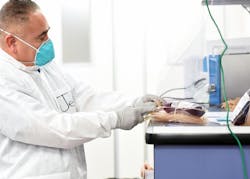Evidence of exposure to SARS-CoV-2 increasing among blood donors
By AABB Communications Staff
A “small but growing” percentage of individuals donating blood show evidence of prior exposure to SARS-CoV-2, according to new findings presented at Sunday evening’s Late-breaking Oral Abstract Session and posted on the AABB 2020 Virtual Annual Meeting blog.
The data, presented by Bryan Spencer, PhD, MPH, research scientist at American Red Cross Scientific Affairs, indicated that while the proportion of blood donors showing evidence of exposure to SARS-CoV-2 is increasing, the demographic and geographic data regarding exposure are consistent with other widely reported findings.
Spencer and his colleagues began testing blood donors for SARS-CoV-2 through the use of a Total Ig Test on June 15, 2020. Donors who were reactive were asked to participate in an online survey two weeks after their donation. The survey inquired about COVID-19-related symptoms and COVID-19 testing performed outside the blood center.
A total of 4,369 donors completed the survey. Of these, 45 percent reported never having symptoms of COVID-19. Spencer said there was no association between the presence of symptoms and other factors, such as chronic illness or obesity.
Among the donors who reported previously experiencing COVID-19 symptoms, fatigue (41 percent), myalgia (35 percent), headache (33 percent), cough (29 percent), loss of smell (29 percent), loss of taste (28 percent) and fever (22 percent) were most commonly reported.
Spencer said that given the importance of identifying individuals who may be eligible to donate COVID-19 convalescent plasma (CCP), identifying patients who self-report previously experiencing more COVID-19-related symptoms may help predict which patients will show evidence of previous exposure to SARS-CoV-2. “Prior symptoms of donors may be useful in identifying suitability for convalescent plasma collection,” he said.

